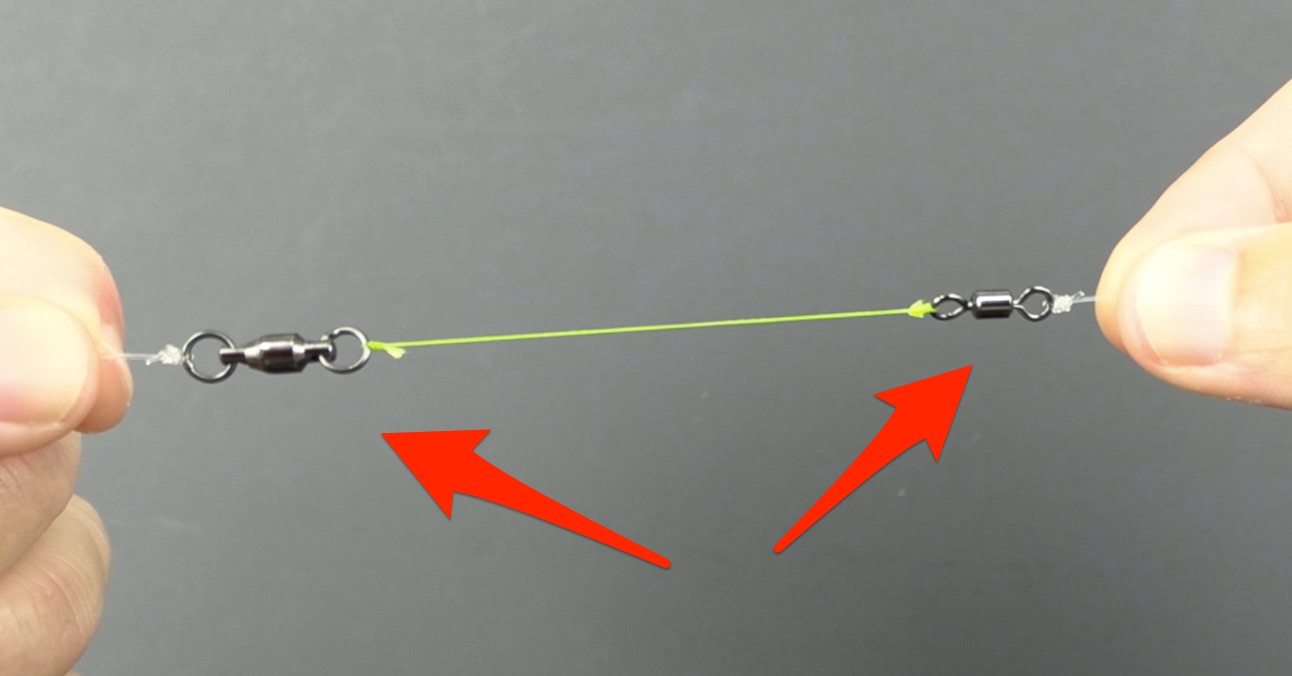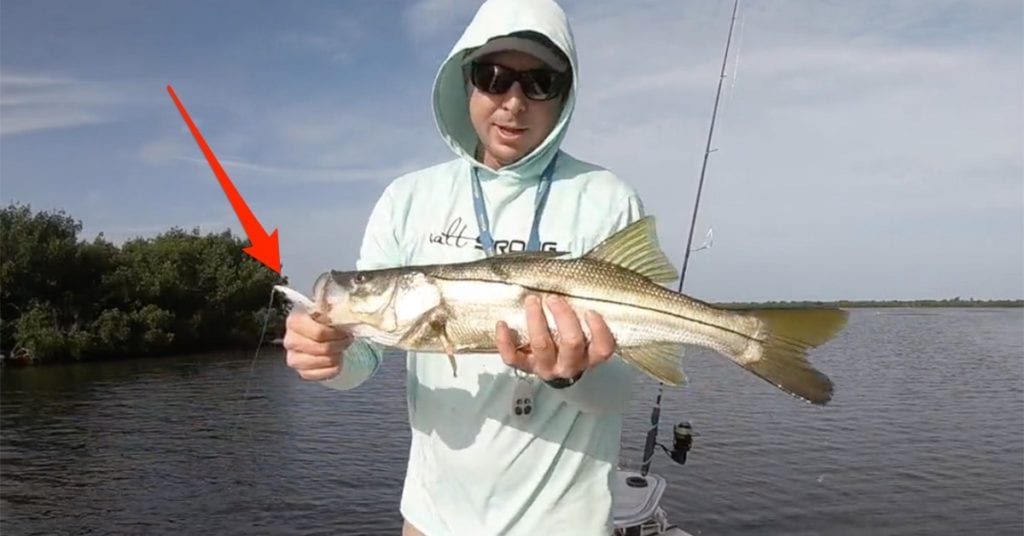Ball Bearing vs. Traditional Swivel: Which Decreases Line Twists More?
- By: Luke Simonds
- on

A few weeks ago, we did a test to see if swivels actually help keep twists out of braided line…
This is important because many people use swivels to keep their line from twisting when using lures that spin, such as spoons (more on this later).
What we found is that braid is so nimble that it can handle lots of twists before the swivel starts kicking in.
In fact, it takes about seven twists per inch of line for the swivel to start spinning.
In conclusion, braided line still gets lots of twists even if you use a swivel…
Now the most common comment on that experiment was, “How does a ball bearing swivel perform in this experiment?”
Well, you ask and we answer!
I went out and got the most expensive ball bearing swivels I could find to do this experiment.
Check out the results below.
P.S. We’re not affiliated with either of these companies, we just wanted to do this experiment and see which one is better.
Ball Bearing Swivel vs. Traditional Swivel [VIDEO]

After testing both a traditional swivel and a ball bearing swivel, here’s what we found…
A traditional swivel starts spinning at around seven twists per inch of line.
A ball bearing swivel, on the other hand, starts spinning at less than two twists per inch of line.
So yes, a ball bearing swivel is much more effective at preventing line twists!
However, here’s the next question: is it worth it?
The ball bearing swivel I used was $2 per swivel (compared to just $0.30 for the regular swivels).
In addition, I haven’t been using swivels when throwing spoons recently and I’ve noticed no decrease in performance.
Plus, when you use a swivel, instead of a line-to-line connection, you’re adding in an extra knot.
And finally, unless you’re retrieving spoons very fast (faster than necessary, usually), then most spoons actually don’t spin.
If they’re weighted properly, they should wobble in the water, but stay upright, so preventing line twists shouldn’t even be an issue.
Conclusion

Yes, ball bearing swivels are much more effective at preventing line twists than regular swivels.
However, they might not be worth it considering they’re much more expensive, and if you use spoons correctly, they shouldn’t spin anyway.
Have any questions about using swivels?
Have you found different results than I have in this experiment?
Let me know in the comments below.
And if you know someone who uses swivels with their lures, please TAG or SHARE this with them!
P.S. Want access to our best fishing spots and tips, plus discounts to our online tackle store? Click here to join us in the Insider Club!
Stop Wasting Your Valuable Time On The Water!
Do what the “SMART ANGLERS” are doing and join the Insider Club.
Here’s what you’ll receive today when you join:
- Weekly fishing reports and TRENDS revealing exactly where you should fish ever trip
- Weekly “spot dissection” videos that walk you through all the best spots in your area
- Exclusive fishing tips from the PROS you can’t find anywhere else
- 20% OFF ALL of your fishing tackle (rods, reels, line, lures, and more from ALL of the biggest brands in America)
Click here to join today.
Related articles:
Related categories:
STOP WASTING TIME ON THE WATER!
Do what the “SMART ANGLERS” are doing and join the Insider Club.
Here’s what you’ll receive today when you join:
- Weekly fishing reports and TRENDS revealing exactly where you should fish every trip
- Weekly “spot dissection” videos that walk you through all the best spots in your area
- Exclusive fishing tips from the PROS you can’t find anywhere else
- Everything you need to start catching fish more consistently (regardless if you fish out of a boat, kayak, or land).










Hey Luke,
I have enjoyed reading your blogs. Great information!
I was wondering if you guys have a recommendation on stainless fishing pliers. I fish saltwater. Would appreciate some feedback when you can. Thanks.
Spray all pliers with corrosive X an they won’t rust as bad
Thanks! I had some good catches trolling spoons with spanish. How fast do you think the spoons start to roll at? I may add a swivel for trolling.
I’m not sure what the precise speed is that makes a spoon start spinning. It most likely depends on the specific spoon being used, so I recommend just dragging it right below the surface so that you can watch it closely to see exactly when it starts doing full rotations.
Great Experiment Luke, Thanks! And good tip to slow down the retrieve to keep the spoon from spinning too much. There are some other factors to consider that are at play, and they affect each other. They are line tension, stiction in the bearing, and friction in the bearing. As the tension in the line increases, then both the stiction and the friction increase. The torque in the line increases with more twists (which is what you demonstrated). To relieve the twists, the torque has to build enough to overcome the bearing stiction to start relieving and then overcome the friction (which is usually less than the stiction) to keep relieving twists. As the twists are being relieved, the torque keeps dropping till friction stops it. So, all the twists will probably never get relieved.
All of that engineering gobbly gook suggests maybe seeing what the # of twists needed for the swivel to relieve them is for different line tensions…… And then maybe measure the line tension created at different retrieve (or trolling) speed
I agree all of this is only worth pondering while waiting for a bite, since it really doesn’t matter a lot…. unless you are retrieving really fast.
Geez, its a little scary when engineers love to fish!!!! 🙂
Chuck
Haha! Anything worth doing is worth overdoing:)
Recently I have lost two overslot reds using a gold spoon. I theorized the fish had used the spoon as leverage to get the hook out of its mouth. Both fish broke off at the beginning of a new run which is why I suspect the placement of the hook on the spoon might have something to do with the loss. What do you think ?
It’s very tough to know for sure what causes hooks to come out when they do.
Not the ball bearing swivels we use for spinning in the UK.
Ours are like longer rolling swivels and pass through most guides.
Still good for grabbing with gloves though.
AFW swivels are always strong enough. Silly strong really.
The issue here is the guage of the wire. The eye will cut the line if the line is thicker than the wire.
Double tuck helps, Flemish Twist to a crimp is by far the best.
All swivels are great for attatching clips and giving a purchase for the Deckie’s gloves.
If you are using a real spinner, say for brownies, a small banana lead or half moon stator really helps.
Must then match to decent ball bearing swivels.
Refering to propellor baits, eg. Devon minnow.
Correct, a decent spoon should flutter, not twist very much.
Slow jigging only involves special rings to split rings.
Always use ball bearing swivels with livebait.
Thorny issue of eels. Freshwater and bloody Congers.
Roller swivels, forget it.
AFWs allow a leader, trace and finally hook length to be disconnected in turn.
Will still be a terrible, slimy mess, but should be recoverable and your nemesis may then be returned.
If you are using 350lb mono to a bronzed hook, forget trying to get the hook out. It will rust out in time and be much safer.
Clip the mono as close as you consider safe.
If you are Belgium and like eating eels, straddle it with the rear of the head over a bait board.
Neutralise it using a T handled stabber. Blade 2″ by 1/4″ with a sharpened V notch in the business end.
Drive it behind the head, through the spine and into the bait board. Skipper will complain if you drive it into his deck.
Re-sharpen regularly. High carbon steel not necessary. The needle sharp prongs will stop it slipping.
Mine, has 10″ round T, welded to a 12″ blade. Butt type caps on the handle and prong guards on the blade.
You need to be close to 200lbs to do it cleanly.
Won’t kill it, eels have two brains, but will disconnect the dangerous bit. A big eel will crush you’re ankle, boot and all!
Eels can also live quite happily out of water for a full tide. Beware loose “dead” eels on the deck!
Alledgedly, a blow with a “Happy Stick” just above the vent will kill the main brain.
I am 250lbs and used to carry a piece of cast iron gas piping, filled with lead at one end. (Stolen).
Just pisses them off!
Old school, big brass swivels, may not swivel much but the micro electro magnetic fields they generate really attract cartilaginous fish.
Best Rgds.
Malcolm Hayward.
Thanks for making time to leave the nice comment Malcolm!
That was an interesting post in terms of a glimpse into another fishing culture. I would enjoy a podcast interview with him to have him translate some of that nomenclature- e.g., small banana lead and a half moon stator. Which raises the question if maybe my problem is I am fishing with a large banana lead and a full moon stator and didn’t even know it. Hard to get my Deckies gloves around that one!
My experiences are consistent with your findings.
. . . “when you use a swivel, instead of a line-to-line connection, you’re adding in an extra knot.” Unless needed, a swivel also adds another component that could fail. Not so much on inshore but occasionally happens offshore on big fish. I prefer black rather than shiny swivels thinking they’re less likely to get cut off if in a feeding frenzy of sharp-toothed fish. Good test!
Always check your connections to avoid tackle failure.
I’ve been confident while using swivels in braid to mono and flouro and wire conections for over 15 years, inshore and offshore, when the weeds are not a problem. I strongly encourage others to use them as well… I also have learned to pre-tie leaders ahead of time. Because, when the bite is on, it doesn’t seem to last very long.
Offshore, nothing has worked better for me than a 40 lb. Spro swivel tied with a haywire twist, to a 20# single strand wire, for the leader shy and razor toothed king mackerel.
Great test, Luke! Good information. I’m very impressed as to how responsive you and all the staff at SaltStrong are to member input. It was just recently we were having the discussion regarding barrel vs ball bearing swivels, and already you have done the trial to answer the question. Just another example how you guys really do consider this a community, not a one-way street, and how it sets SaltStrong above the rest.
Thanks for making time to leave the nice comment Ted!
Luke. What do you attach your spoon to the swivel with? If the spoon get corroded does is it still useable? Mine looks like a speckled trout from corrosion.
I don’t use swivels anymore when using spoons because they didn’t seem to help much.
Yes, a spoon can catch fish even after it looses its shine.
Good Stuff Luke and my question answered.. Thank You!
Glad to see that you enjoyed this swivel experiment!
Nice review – do you think doing this in water makes any difference?
The water should slightly help keep the line from twisting, so the real world twists will likely be a bit better than these air tests.